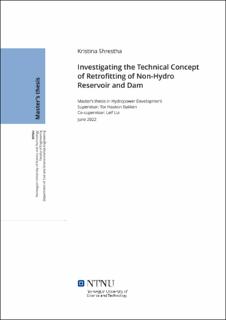| dc.description.abstract | The number of dams build explicitly for the purpose of power production is increasing gradually due to the global increase in energy demand. This increment in energy demand has caused gradual shift from fossil fuels to renewable energy options. This has encouraged developments, innovations, and optimizations in the renewable energy sector. One of the developments in this sector is retrofitting of the preexisting non-power dams. Retrofitting of a non-power dam is done by installing power generating unit while maintaining the integrity and the compatibility with the purpose the dam was originally built for. However, before any intervention to dam there should be proper analysis whether this technology will affect the existing water demand site. Similarly, the economics involving the costs of different retrofitting alternatives should also be investigated prior to its implementation.
This study aims at finding the hydropower potential of the most feasible option of a non-powered dam without the intervention of existing water use. For this, a study location is selected in Kiringya district in Central Kenya on the River Thiba on the tributary of River Tana. The study is based on Upper Tana subbasin on Thiba Dam, whose main purpose is to supply water to Mwea Irrigation Scheme (MIS). For evaluating the water availability, a hydrological model (WEAP) is used which is calibrated from period between 1978 to 1995 with monthly time step where the parameters are calibrated for the streamflow discharge data of an unregulated sub-basin. CROPWAT software is used to find the Irrigation Water Requirement (IWR) in MIS. Using this IWR, the water demand for MIS is fixed which governs the release of water from the dam. Two technical solutions have been opted for retrofitting viz. pipe and weir scheme. Economic analysis for both schemes is done, and the most feasible option is recommended.
The result from the hydrological model shows NSE and PBIAS of 54% and -8.27% in calibration respectively. There is monthly variation in irrigation water demand in MIS with an annual total of 567.5 mm/ha. The potential from pipe scheme is 4.91 MW whereas from diversion weir scheme is 3.7 MW. Both selected schemes are financially sound; however, the pipe scheme is more feasible than weir scheme from all financial indicators. It is evident from this study that retrofitting of dam for power generation is economically beneficial than construction of completely new hydropower in a pristine river. From this study, it is also evident that the scheme which taps the water directly from the dam and utilizes its head has more benefit than other options in retrofitting. | |
